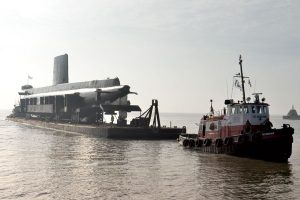Former RCN Submarine now a small town treasure
By Lookout on Jun 23, 2016 with Comments 0

HMCS Ojibwa is towed into Port Burwell Nov. 20, 2012, on the north shore of Lake Erie prior to making its way to the Elgin Military Museum.
Peter Mallett, Staff Writer ~
This summer if you are anywhere near Port Burwell, Ontario, seek out the sleek, cylindrical body of a former Royal Canadian Navy submarine.
HMCS Ojibwa (S72) was an Oberon class submarine that served the navy from 1965 to 1998 when it was decommissioned. It was saved from destruction in 2010 by the Elgin Military Museum, who saw its potential as a land-based submarine exhibit.
The 88-metre long and five story high submarine now rests on dry land just a stone’s throw from Lake Erie as a key exhibit for the Museum. Though its days as an RCN asset have long since passed, Ojibwa remains a technological marvel and constant attention grabber, says the museum’s executive director, Ian Raven.
“When you stick a vessel that measures close to 300 feet and weighs 2.8 million pounds, hundreds of miles from the ocean and in a tiny community like this one, it certainly stands out and catches people’s attention,” he says. “It’s amazing how many people that look and point to it when they drive through town and stop by to ask us ‘is that really a submarine?’ then pose for pictures beside it.”
Ojibwa spent most of her career on the East Coast with Maritime Forces Atlantic, but had two short deployments at CFB Esquimalt in 1977 and 1997. The boat was acquired by the museum in 2012 and towed by tug boat to the rural southwestern Ontario harbour town – population 7,000, located 72 kilometres southeast of London.
Raven said the exhibit, which cost approximately $8.5 million to refurbish for guided tours, is part of a larger effort by the museum to celebrate and document the contribution of over 9,000 Elgin residents who served their county since the War of 1812.
“Since they made such huge sacrifices for the freedoms all Canadians enjoy today, we want to give the museum’s visitors a true understanding, and realistically commemorate what the submariners who worked on this vessel experienced on a day-to-day basis,” said Raven. “Most Canadians have no idea what these submariners did for us, the sacrifices they made and how they lived their lives aboard vessels such as Ojibwa. It’s not the piece of steel or the physical sub itself that accomplished its legacy, but the human crew of the vessel.”
Although much of the electronic equipment in Ojibwa’s radar and sonar rooms were removed before the ownership transfer of the vessel, Raven says he and his staff pride themselves on the authenticity factor they made to ensure it retains the same “operational atmosphere” it had in the RCN.
He also noted huge logistical challenges in rewiring the boat, because of its tight spaces, for basic requirements as lighting and air conditioning, since much of the original electrical circuitry inside Ojibwa had been removed prior to its arrival.
Guided tours for up to 10 visitors are conducted by museum staffers, including former RCN submariners, and normally take close to one hour. If museum-goers can adjust to the confined spaces, the tour normally gets rave reviews.
Ojibwa is also showing potential as a future set for the film and television industry. Raven said the vessel recently captured the interesrt of an undisclosed Hollywood production crew that travelled to Port Burwell and boarded Ojibwa for insight into how to build movie set inside a submarine.
Meanwhile Canadian television program Dino Dana filmed segments for a future show from the boat.
Filed Under: Top Stories
About the Author:





